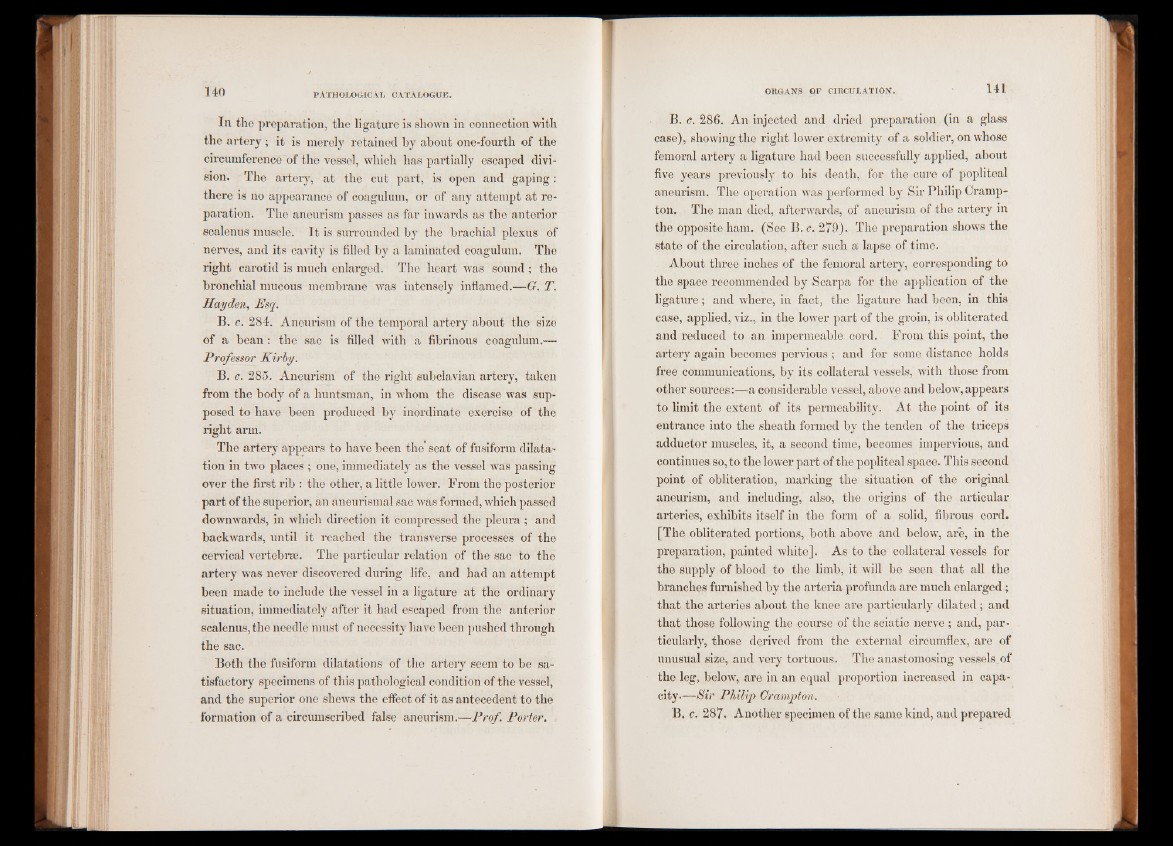
In the preparation, the ligature is shown in connection with
the artery; it is merely retained by about one-fourth of the
circumference of the vessel, which has partially escaped division.
The artery, at the cut part, is open and gaping:
there is no appearance of coagulum, or of any attempt at reparation.
The aneurism passes as far inwards as the anterior
scalenus muscle. It is surrounded by the brachial plexus of
nerves, and its cavity is filled by a laminated coagulum. The
right carotid is much enlarged. The heart was sound; the
bronchial mucous membrane was intensely inflamed.—G. T.
Hayden, Esq.
B. c. 284. Aneurism of the temporal artery about the size
of a bean: the sac is filled with a fibrinous coagulum.—
Professor Kirby.
B. c. 285. Aneurism of the right subclavian artery, taken
from the body of a huntsman, in whom the disease was supposed
to have been produced by inordinate exercise of the
right arm.
The artery appears to have been the seat of fusiform dilatation
in two places ; one, immediately as the vessel was passing
over the first rib : the other, a little lower. From the posterior
part of the superior, an aneurismal sac was formed, which passed
downwards, in which direction it compressed the pleura ; and
backwards, until it reached the transverse processes of the
cervical vertebrae. The particular relation of the sac to the
artery was never discovered during life, and had an attempt
been made to include the vessel in a ligature at the ordinary
situation, immediately after it had escaped from the anterior
scalenus, the needle must of necessity have been pushed through
the sac.
Both the fusiform dilatations of the artery seem to be satisfactory
specimens of this pathological condition of the vessel,
and the superior one shews the effect of it as antecedent to the
formation of a circumscribed false aneurism.—Prof. Porter.
B. c. 286. An injected and dried preparation (in a glass
case), showing the right lower extremity of a soldier, on whose
femoral artery a ligature had been successfully applied, about
five years previously to his death, for the cure of popliteal
aneurism. The operation was performed by Sir Philip Cramp-
ton. The man died, afterwards, of aneurism of the artery in
the opposite ham. (See B. c. 279). The preparation shows the
state of the circulation, after such a lapse of time.
About three inches of the femoral artery, corresponding to
the space recommended by Scarpa for the application of the
ligature; and where, in fact, the ligature had been, in this
case, applied, viz., in the lower part of the groin, is obliterated
and reduced to an impermeable cord. From this point, the
artery again becomes pervious ; and for some distance holds
free communications, by its collateral vessels, with those from
other sources:—a considerable vessel, above and below, appears
to limit the extent of its permeability. At the point of its
entrance into the sheath formed by the tenden of the triceps
adductor muscles, it, a second time, becomes impervious, and
continues so, to the lower part of the popliteal space. This second
point of obliteration, marking the situation of the original
aneurism, and including, also, the origins of the articular
arteries, exhibits itself in the form of a solid, fibrous cord.
[The obliterated portions, both above and below, are, in the
preparation, painted white]. As to the collateral vessels for
the supply of blood to the limb, it will be seen that all the
branches furnished by the arteria profunda are much enlarged;
that the arteries about the knee are particularly dilated; and
that those following the course of the sciatic nerve ; and, particularly,
those derived from the external circumflex, are of
unusual size, and very tortuous. The anastomosing vessels.of
the leg, below, are in an equal proportion increased in capacity.—
Sir Philip Crampton.
B. c. 287. Another specimen of the same kind, and prepared